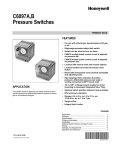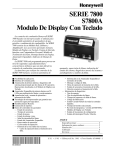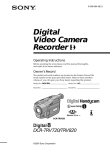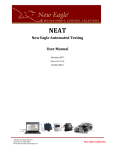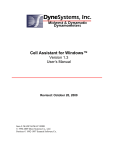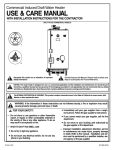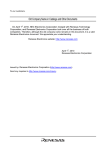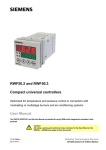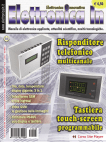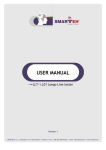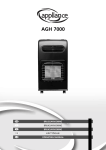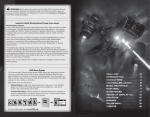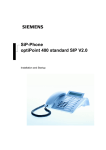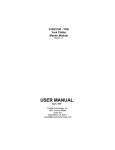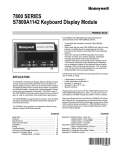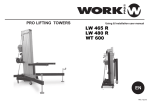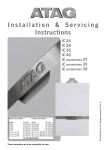Download 3100/3150-CBM User Manual
Transcript
3100/3150 - CBM Honeywell ControlBus™ Master Module Revision 1.0 USER MANUAL February, 1998 ProSoft Technology, Inc. 9801 Camino Media Suite 105 Bakersfield, CA 93311 [email protected] Please Read This Notice Successful application of the CBM card requires a reasonable working knowledge of the Allen-Bradley PLC or SLC hardware and the application in which the combination is to be used. For this reason, it is important that those responsible for implementing the CBM satisfy themselves that the combination will meet the needs of the application without exposing personnel or equipment to unsafe or inappropriate working conditions. This manual is provided to assist the user. Every attempt has been made to assure that the information provided is accurate and a true reflection of the product's installation requirements. In order to assure a complete understanding of the operation of the product, the user should read all applicable Allen-Bradley documentation on the operation of the A-B hardware. Under no conditions will ProSoft Technology, Inc. be responsible or liable for indirect or consequential damages resulting from the use or application of the CBM product. Reproduction of the contents of this manual, in whole or in part, without written permission from ProSoft Technology, Inc. is prohibited. Information in this manual is subject to change without notice and does not represent a commitment on the part of ProSoft Technology, Inc. Improvements and/or changes in this manual or the product may be made at any time. These changes will be made periodically to correct technical inaccuracies or typographical errors. ProSoft Technology, Inc. 1996, 1997, 1998 Product Revision History 10/01/96 Revision 1.0 Initial release of product 02/04/98 Updated manual to include the point lists from Honeywell for each of the products i Implementation Guide Integration of the CBM module into a PLC or SLC application is easier the first time if a series of steps are followed. In order to assist the first time users of our products in getting the CBM operational quickly, we have come up with this step-by-step implementation guide. a) b) Starting with one of the ladder logic programs provided on disk with the CBM complete the following steps: PLC 5 CBM5 SLC 5/03 CBM503 (See Appendix for SLC programming tips) Edit the ladder logic provided on disk as needed for the application Verify rack and slot location in program Modify ladder instruction addresses as needed c) Setup the Communication Configuration parameters (See Section 2) Determine each port’s communication configuration requirements d) Setup the Polling List for each port (See Section 2) Be sure to review register map of slave device to build most effective memory map e) Setup the Device Definition Files for each of the devices to be addressed (See Section 2) This is where the user is able to determine the Point Numbers in each of the devices which are to be brought back to the ladder logic. Up to 20 points can be defined per Point Definition File f) Identify the jumper requirements (See Appendix) g) Make up the communication cables (See Section 5) h) Place processor into the run mode i) Monitor the data table for the Error Status values (See Section 2) ii Table of Contents Revision History Implementation Guide i ii 1 Product Specifications ............................................................................................................................1 2 CBM Theoretical Operation.....................................................................................................................1 2.1 Block Transferring Data to the Module .............................................................................................2 2.1.1 Communications Configuration [ BTW Block ID 255 ] ................................................................2 2.1.2 Writing Poll Command Lists to Module[ BTW Block ID 80 to 99 ] ..............................................4 2.1.3 Executing Write Commands [ BTW Block ID 100 to 119 ]..........................................................6 2.1.4 Writing Device Definition Files [BTW Block ID 120 to 159].........................................................7 2.2 Block Transferring data from the module..........................................................................................8 2.2.1 Reading Slave Data ..................................................................................................................9 2.2.2 Reading Diagnostic/Status Data ................................................................................................9 2.2.3 Error Status Codes..................................................................................................................11 3 Protocol Commands.............................................................................................................................11 3.1 CBM Commands ...........................................................................................................................12 3.1.1 Cmd #1 - rpa - Read Point Command .....................................................................................12 3.1.2 Cmd #2 - rpqa - Read Point Qualified Command.....................................................................12 3.1.3 Cmd #3 - wpa - Write Point Command ....................................................................................12 3.1.4 Cmd #4 - wpqa - Write Point Qualified Command ...................................................................12 3.1.5 Cmd #5 - sn - Set Node Number .............................................................................................12 4 Hardware Diagnostics...........................................................................................................................12 4.1 3100 PLC Platform ........................................................................................................................13 4.2 3150 SLC Platform ........................................................................................................................14 4.3 Troubleshooting .............................................................................................................................14 5 Cable Connection .................................................................................................................................15 Appendix Support, Service and Warranty Jumper Configurations SLC Programming Considerations Setting a Slave Node Address Writing values to a slave Device Definition File Form Honeywell Point List Example Ladder Logic PLC-5 SLC-5/03 1 Product Specifications The 3100/3150-CBM ( Honeywell ‘ControlBus™ Module’(CBM) Master) product family allows Allen-Bradley 1771 and 1746 I/O compatible processors to interface easily with Honeywell 7800 Series controls and BCS 7700 systems. The CBM product includes the following standard features: • Two fully configurable serial ports, each capable of supporting the CBM Master functionality using the ASCII mode of communications • RS-485 connection from each port directly to Honeywell QS7850A interface modules • Supports up to 32 Honeywell nodes per serial port • Supports polling of rpa command accessible data using the integer data type • Floating point values are scaled x 10 by module • ASCII text strings are not supported • Supports one-shoted writes using to wpa/wpqa accessible data from ladder logic • Up to 40 ‘device config files’ are available for user configuration • Communication configuration (From processor ladder logic) Node Addr : 0, 8 to 255 Baud Rate : 300 TO 38,400 (9600 baud only supported by Honeywell) Response Timeout Parity : None (fixed) Stop Bit : 1 (fixed) Mode : ASCII (fixed) • Supported CBM command codes: rpa : Read Point rpqa : Read Point Qualified wpa : Write Point wpqa : Write Point Qualified sn : Set Address • Error Codes returned to the ladder processor along with a poll execute toggle bit • Response time The protocol drivers are written in Assembly and in a compiled higher level language. As such, the interrupt capabilities of the hardware are fully utilized to minimize delays, and to optimize the product's performance 2 CBM Theoretical Operation Data transfers between the processor and the ProSoft Technology module occur using the Block Transfer commands, in the case of the PLC, and M0/M1 data transfer commands, in the case of the SLC. These commands transfer up to 64 physical registers per transfer. The logical data length changes depending on the data transfer function. The following discussion details the data structures used to transfer the different types of data between the ProSoft Technology module and the processor. The term 'Block Transfer' is used generically in the following discussion to depict the transfer of data blocks between the processor and the ProSoft Technology module. Although a true Block Transfer function does not exist in the SLC, we have implemented a pseudo-block transfer command in order to assure data integrity at the block level. Examples of the PLC and SLC ladder logic are included in Appendix A. In order for the ProSoft Technology module to function, the PLC must be in the RUN mode, or in the REM RUN mode. If in any other mode (Fault/PGM), the block transfers between the PLC and the module will stop, and communications will halt until block transfers resume. 1 2.1 Block Transferring Data to the Module Data transfer to the module from the processor is executed through the Block Transfer Write function. The different types of data which are transferred require slightly different data block structures, but the basic data structure is: Word 0 1-63 Description BTW Block ID code Data Although the full physical 64 words of the data buffer may not be used, the BTW and M0 lengths must be configured for 64 words otherwise module operation will be unpredictable. Where: BTW Block ID Code: A block identifier code between 0 and 255 in value. This code is used by the ProSoft module to determine what to do with the data block. Valid codes are: BTW Code 80-99 100-119 120-160 255 Description Polling Command List Write Commands Device Definition Lists Module Configuration Data: The data to be written to the module. The structure of the data is dependent on the Block ID code. The following sections provide details on the different structures. 2.1.1 Communications Configuration [ BTW Block ID 255 ] The ProSoft Technology firmware communication parameters must be configured at least once when the card is first powered up, and any time thereafter when the parameters must be changed. On power up, the module enters into a logical loop waiting to receive configuration data from the processor. While waiting, the module sets the second word of the BTR buffer to 255, telling the processor that the module must be configured before anything else will be done. The module will continuously perform block transfers until the communications configuration parameters block is received. Upon receipt, the module will begin execution of the command list if present, or begin looking for the command list from the processor. Issuing a 255 Configuration command will cause the module to act as if it has been powered down. The Polling Command List, the Write Commands and the Device Definition Files will be cleared The configuration data block structure which must be transferred from the processor to the module is as follows: BTW Block ID 255 Word 0 1-10 11-20 21-30 Description BTW Block ID = 255 Port 1 Configuration parameters Port 2 Configuration parameters System Configuration parameters BTW Example Buffer Address 0 Port 1 Configuration 1 N7:0 2 N7:1 2 Description Block ID Header = 255 Baud Rate Response Timeout 3-10 N7:2-9 Port 2 Configuration 11 N7:10 12 N7:11 13-20 N7:12-19 System Configuration 21 N7:20 22 N7:21 23 N7:22 24 N7:23 25 N7:24 26 N7:25 27 N7:26 Baud Rate Spare Baud Rate Response Timeout Spare Read Block Count Write Block Count Command Block Count Error Pointer Spare Spare Device Definition File Count Response Timeout 0 1 2 3 4 5 6 7 8 9 N7:0 5 2000 0 0 0 0 0 0 0 0 Port #1Configuration N7:10 5 2000 0 0 0 0 0 0 0 0 Port #2 Configuration N7:20 5 0 4 130 0 0 5 0 0 0 System Configuration Read Blk Cnt Command Blk Cnt Error Pointer Device Definition File Cnt Example Configuration Block Where: Baud Rate: The baud rate at which the module is to operate. The baud rate is configured as follows: Value 0 1 2 3 4 5 6 7 Baud Rate 300 Baud 600 Baud 1200 Baud 2400 Baud 4800 Baud 9600 Baud (Honeywell default) 19200 Baud 38400 Baud The module’s two ports are limited to an upper baud rate of either 19200 or 38400 baud. The module cannot be configured with one port at 19200 and the other at 38400. If an attempt is made to configure the module in this fashion, a Port Configuration Error will be returned. Message Response Timeout: This register represents the message response timeout period in 1 ms increments. This is the time which a port configured as a Master will wait before re-transmitting a command if no response is received from the addressed slave. The value is set depending on the expected slave response times. The allowable range of values is 0 to 65535(0xffff). If a zero value is entered, the module will default to a one second timeout value (3000 ms). System Configuration Read Data Block Count: This value represents the number of 50 word data blocks which are to be transferred from the module to the processor. The blocks returned from the module start at block 0 and increment from there. The maximum block count is 80. 3 As an example, a value of 5 will return data blocks 0, 1, 2, 3, and 4, or module registers 0 to 249. If a value greater than 80 is entered, a System Configuration Error is activated Command Block Count: This value represents the number of 50 word Command Blocks which are to be transferred from the processor to the module. This value will be 0 if the module will not be configured with a Master port. See the discussion in Section 2.1.2 for details on the number of Command Blocks needed. The maximum block count is 20. If a value greater than 20 is entered, a System Configuration Error is activated Error Block Pointer: This value represents the relative starting position in the module's data table within which the Error Data Block is placed. The Error Table is a 131 word block containing module revision level information as well as slave polling status. The error data can be placed anywhere in the module’s data space (0 to 3999). The contents of the Error Table can then be obtained as part of the regular Register Data. If a value greater than 3850 is entered, a System Configuration Error is activated Device Definition File Count: This value represents the number of Device Definition Files which will be defined by the ladder logic application. This value is used by the module to determine which how many definition files to request during a power-up or re-configuration sequence. If a value greater than 40 is entered, a System Configuration Error is activated 2.1.2 Writing Poll Command Lists to Module[ BTW Block ID 80 to 99 ] A CBM Master port establishes communications and performs various communications functions based on the data which the user has placed in the Poll Command List. The command list consists of up to 100 individually configured command data blocks (10 words reserved per command) which are shared between the two available ports. This list, entered into the processor Data Table, is transferred to the module's memory using Block ID codes 80-99 with each code representing a 50 word block, or 5 commands. BTW Buffer Word 0 1-10 11-20 21-30 31-40 41-50 Description BTW Block ID Code (80-99) Command Config - Pos. #1 Command Config - Pos. #2 Command Config - Pos. #3 Command Config - Pos. #4 Command Config - Pos. #5 BTW Block ID: The block identifier number allows the CBM Module to decode which portion of the command configuration table is being written. Valid numbers for the BTW Block ID are between 80 and 99, inclusive, with 80 representing the beginning of the command list, commands 1 to 5, and 99 representing commands 95 to 99. 4 Command Config Data: The Command Configuration Data consists of the command list data outlined in the above discussion. A command configuration block consists of the data necessary for the module to encode a valid command, to transfer data from a slave to the master's memory. The structure of the command configuration data block is as follows: Block Address 0 Example Address N11:0 Name Description Port Select The Port Select parameter allows the application to select which port the CBM Module will use to execute the command. Valid values are: Port Description 1 Port 1 Command 2 Port 2 Command This value represents the Node address assigned to the QS7850A module to which the command is to be directed. Valid values are between 8 and 255 Used to instruct the module which of the supported commands to execute. In the Poll Command List table the valid entries are: Cmd Description 1 rpa Read Point 2 rpqa Read Point Qualified This value represents the SN (Slot Number) for rpa commands and the NN (Network Number) for rpqa commands This value is used by the module to reference the point list configured in the Device Definition File. The relationship between the value entered here and the Files themselves is as follows: Value Block Transfer 0 120 - File Number 0 2 121 - File Number 1 39 159 - File Number 39 The CBM module register address in which the data being read from the slaves will be returned. As an example, a value of 50 would place the slave data block starting at register 50 in the CBM module and return the data to the processor when Block ID 1 is read Used only for the RPQA command to identify the Device Address of the unit to read from The RPQA Point Number to be read 1 N11:1 Node Address 2 N11:2 Command 3 N11:3 Slot Number/ Network Number 4 N11:4 Device Definition File 5 N11:5 Destination Address 6 N11:6 7 N11:7 8 N11:8 rpqa DA (Device Address) rpqa PP (Point Number) rpqa PQ (Point Qualifier) 9 N11:9 Spare 5 The RPQA Point Qualifier which must be sent to reference the point. This value is available from Honeywell point tables. Not used at this time. Fill with 0 Port Select Node Addr Command Device Definition File number Slot Number Destination Address 0 1 2 3 4 5 6 7 8 9 N11:0 1 0 0 0 0 0 0 0 0 0 Comand #1 N11:10 1 1 0 0 0 0 0 0 0 0 Comand #2 N11:20 0 0 0 0 0 0 0 0 0 0 Comand #3 N11:30 0 0 0 0 0 0 0 0 0 0 Comand #4 N11:40 0 0 0 0 0 0 0 0 0 0 Comand #5 Example Command List Block N11:0 2 8 1 5 0 0 0 0 0 0 RPA Command issued out port 2 to slave #8. The command references the Point Definition File 0 and places the results in Word 0 of the module. N11:10 2 8 2 5 0 4 34 10 224 0 RPQA Command issued out port 2 to slave #8. The command is issued to an S7830 to read Point Num 10 with a qualifier 224. The results are placed in register 4 in the module. 2.1.3 Executing Write Commands [ BTW Block ID 100 to 119 ] A CBM Master port is capable of executing single register write commands to slave devices on the ControlBus network. The write commands are executed and one-shoted by the module on a priority basis over commands in the Poll Command List. Only one write command can be initiated per Block Transfer. The write command is initiated by writing a data block from the processor containing the information necessary for the module to encode a valid command message, including the data to be transferred. The structure of the write message block transfer data is: BTW Buf Address 0 Example Address Name Description BTW Block ID 100 to 119 This value is used by the ladder logic and by the module to determine which command is executing. The module will return the error status value in the relative position in the Error Table based on the Block ID number (i.e.,. the Command executed by Block ID 100 will have a status value returned in position 112 in the table (See Error Table section) The Port Select parameter allows the application to select which port the CBM Module will use to execute the command. Valid values are: Port Description 1 Port 1 Command 2 Port 2 Command This value represents the Node address assigned to the QS7850A module to which the command is to be directed. Valid values are between 8 and 255 Used to instruct the module which of the supported commands to execute. In the Command List table the valid entries are: 1 N12:0 Port Select 2 N12:1 Node Address 3 N12:2 Command 6 Cmd 3 4 5 4 N12:3 Slot Number/ Network Number/ QS7850 Node Adr 5 N12:4 Device Address 6 N12:5 7 N12:6 Destination Pt Number Pt Qualifier 8 N12:7 Data Value 9 N12:8 Format 10 N12:9 Scaling 2.1.4 Description wpa Write Point wpqa Write Point Qualified sn Set Node Address Ref Appendix for sn Cmd This value represents the SN (Slot Number) for wpa commands, the NN (Network Number) for wpqa commands, and the Node Address for sn commands This value is used to select the particular device and type of device which is on a slot. Valid values at this time are: 17 QM40XX 18 Trapscan 19 Pulseatrol 20 for the BCS7700 32 for the RM78XX 34 for the S7830 The Point Number in the slave in which the write command is to place a value A value which must be sent when performing a wpaq command. The value is defined by Honeywell on a per point basis (See Appendix point listing or Honeywell Reference 206610 Q7850 diskette The value which will be written into the slave Point. Note that floating point values should be entered as integers x 10 The format value as defined by Honeywell for the appropriate command The scaling value as defined by Honeywell for the appropriate command Writing Device Definition Files [BTW Block ID 120 to 159] The Device Definition Lists are used by the CBM module when building a Read Point Command to determine which points to read. Up to 40 Device Definition Lists may be entered in the processor data table. Devices with the same Device Address and the same list of points to read can reference an individual Device Definition File multiple times (i.e., if there are 6 of the same devices on a network and all of the same points are to read out of each device, then only one Device Definition File needs to be created, although 6 entries will still need to be made in the Poll Command List). Movement of the Device Definition Files occurs automatically only on power-up or anytime a module reconfiguration (Block ID 255) is issued to the module. The example ladder logic in the Appendix references a method for setting up the Device Definition Files and for moving them in ladder logic into the Block Transfer Write buffer. The structure of the Device Definition File is as follows: BTW Buf Address Example Address 0 1 N120:0 Name Description BTW Block ID 120 to 159 This value is used by the ladder logic and by the module to determine where to place the File data. The Poll Command List entries will reference the File numbers starting at 0 such that the entry placed in the module with Block ID 120 will be referenced as 0. This value is used to select the particular device Device Address 7 2 2.2 N120:1 to 121 Point Number List and type of device which is on a slot. Valid values at this time are: 17 QM40XX 18 Trapscan 19 Pulseatrol 20 for the BCS7700 32 for the RM78XX 34 for the S7830 A list of the Point Numbers which are to be read from the slave devices Block Transferring data from the module When the Master port driver reads data from a slave, the resulting data is placed into the ProSoft module’s data space. This Module Data space is then transferred to the PLC/SLC. The transfer of data from the ProSoft Technology module to the processor is executed through the Block Transfer Read function. The data structure for the block transfer is predefined and detailed below. Although the full physical 64 words of the data buffer may not be used, the BTR and M1 lengths must be configured for a length of 64 words, otherwise module operation will be unpredictable The ladder logic must be programmed to look at the BTR buffer, decode several words, and then take action. The BTR buffer definition is: Word 0 1 2-62 Description BTR Block ID BTW Block ID Data BTR Block ID Number: The ladder logic uses this value to determine the contents of the data portion of the BTR buffer. With some conditional testing in ladder logic, the data from the module can be placed into the PLC/SLC data table. BTW Block ID Number: The module returns this value to the processor to be used to enable the movement of Poll Command List blocks and Device Definition File Blocks to the module. The BTW Block ID number is developed by the module based on the value entered in parameter 22 of Block 255. This value is intended to only be a suggestion and to ease the ladder logic programming requirements. If it is desired to develop a different data transfer series, this may be easily accomplished through ladder logic. BTR Buffer Word 0 1 2 3 4 : : : 63 BTR Block ID BTW Block ID BTW Buffer Word 0 1 2 3 4 : : : 63 BTW Block ID Data: The contents of the module’s Register Data space containing the status and results of the polling of the slaves. The values will be 16 bit register values and floating point values, and should be placed into integer files. Note that the user application ladder logic controls the placement and use of the data registers. 8 2.2.1 Reading Slave Data Data which has been read from the slave devices is deposited into a 4000 word register table in the module. This table is addressed starting at 0 and going up to 3999. The data register table is transferred from the module to the ladder logic through a paging mechanism designed to overcome the 64 physical word limit of the BTR instruction. The paging mechanism is outlined in the discussion above, but the important thing to understand is the relationship between the page numbers (BTR Block ID numbers) and the register addresses in the module. The relationship between the BTR Block ID number and the register table can be put into an equation: Starting Register Address = Block ID Number * 50 The following diagram also shows the layout for an example application. Note the number of blocks returned from the module to the ladder logic is determined by the value entered in the System Configuration ‘Read Block Cnt’ register (See Section 2.1) CBM Module Memory PLC Data Memory PLC Data Addr N10:0 Read Data Block Block ID 0 to 79 Address : 0 to 3999 0 N10:50 49 50 N10:100 99 100 N10:150 149 150 N10:200 199 200 N10:250 249 250 N10:300 299 300 Block ID 0 Block ID 1 Read Data from Slaves to PLC These data registers (0 to 139) will be the destination addresses for the Commands in the Poll Command List Block ID 2 Error Table Pointer= 140 Block ID 3 Block ID 4 Error Table These data registers (140 to 270) will contain the Error Table (presuming an Error Table Pointer of 140). Block ID 5 Block ID 6 349 350 Block ID 79 3999 Read Data Blocks from CBM Module (example only) 2.2.2 Reading Diagnostic/Status Data The module monitors the status of all commands. This status is communicated to the processor as part of an Error Table, the position of which is controlled by the Error Table Pointer in the Communication Configuration setup. Each Poll Command entry will generate an Error Code for use by the user. The Error Table is initialized to zero on power up and every time the module receives the 255 configuration data block. The Error Table is a total of 131 words in length. The simplest method for obtaining the Error Table is to locate it at the end of the application’s data map and then read it back into the PLC/SLC data table as part of the regular data. The position of the Error Table in the module’s memory is user determined by the Error Table Pointer in the Module Configuration Block (See Section 2.1). 9 The structure of the Error Table is as follows: Word System Information 0-1 2-3 4-5 6-7 8-9 Description Product Name (ASCII) Revision (ASCII) Operating System Rev(ASCII) Production Run Number (ASCII) Spare Poll Command Status 10 Command List End of Poll Status 11 Command #1 Error Status 12 Command #2 Error Status 109 Command #99 Error Status 110 Command #100 Error Status 111-130 Write Command Status Where: Product Name: These two words represent the product name of the module in an ASCII representation. In the case of the CBM product, the letters ‘ CBM ‘ should be displayed when placing the programming software in the ASCII data representation mode. Revision : These two words represent the product revision level of the firmware in an ASCII representation. An example of the data displayed would be ‘1.00’ when placing the programming software in the ASCII data representation mode. Operating System Revision : These two words represent the module’s internal operating system revision level in an ASCII representation. Production Run Number: This number represents the ‘batch’ number that your particular chip belongs to in an ASCII representation. Command List End Of Poll Status: This register provides an indication of when the Master has completed one cycle through the Command List. A bit in the word will be toggled each time the command list has been completed. The status is indicated for each master port as follows: Bit 0 Port 1 1 Port 2 Command Error Status: The Error Status Codes, either received from the slaves, or generated by the module, are placed in the table. The Error and Status information is split into a High and Low byte format as follows: High Byte Command Execute Toggle Low Byte Error Status Code See the next section for the meaning of the Error Codes. The values will be 16 bit values, and should be placed into an integer file. The relationship between the placement of the error codes within the Error Table and the commands is according to the command’s relative position in the command list. Wrd 0 N10:140 CB Wrd Wrd Error Status Table Example Error Table Pointer = 140 Wrd Wrd Wrd Wrd Wrd Wrd Wrd 1 2 3 4 5 6 7 8 9 M 1. 00 08 01 0 0 0 0 10 N10:150 0 8 0 0 0 0 0 0 0 N10:160 0 0 0 0 0 0 0 0 0 0 0 N10:170 0 0 0 0 0 0 0 0 0 0 N10:180 0 0 0 0 0 0 0 0 0 0 N10:190 0 0 0 0 0 0 0 0 0 0 N10:200 0 0 0 0 0 0 0 0 0 0 N10:210 0 0 0 0 0 0 0 0 0 0 Note that registers N10:140-149 must be viewed in ASCII mode to determine revision information. In this case an error code of 8 was generated for Poll Command 2 -- all other commands were executed without any errors. 2.2.3 Error Status Codes The Error Codes returned in the low byte of each word in the Error Table reflects the outcome of the commands and responses executed by the module. Note that in all cases, if a zero is returned, there was not an error. Valid Error Status Codes are as follows: Code 0 1 3 Name All ok LF Not Found 2 Error Message Resp 3 No Response 4 Bad Response 5 6 Bad Op Code Wrong Cmd Byte Cnt 7 8 Read Only Point Timeout Error 9 ASCII Error 10 Buffer Overflow 16 Port Configuration Error 18 System Configuration Error 255 TX Hardware Timeout Protocol Commands 11 Description The module is operating as desired A Line Feed character which was expected was not detected while parsing the data from the slave An ASCII error response was returned as a result of the command A ‘No Response’ message was received from the QS7850 indicating that the addressed slave did not respond to the requested command Parsing of the response from the slave generated an unexpected error condition. If the ERR LED is on solid with this code then reset the Q7700 as messages may be out of sync. An unsupported command was attempted A ‘Wrong Command Byte Count’ message was received from the QS7850 indicating that the command was not structured correctly A Write command was attempted to a read only point Communications with the addressed QS7850 have been unsuccessful and have timed out. Assure that the Response Timeout value is large enough for the application if the error code is intermittent An error response has been received from the QS7850 as a result of the command that was sent. Verify that valid points are being requested. The receive buffer has overflowed and reset the character count to 0. If this condition occurs try reading fewer parameters at one time If this error is returned it is because the module has detected an invalid port configuration request. Verify the baud rate settings if this error occurs If this error is returned from the module, one of the system configuration parameters has been detected out of range. To determine the source, verify the following: - Read Block Count <= 80 - Command Block Count <= 20 - Error Pointer <= 3850 - Dev Def File Cnt <= 40 A transmit timeout condition has occurred indicating that the module was not able to transmit the command. Verify that the RTS-CTS jumper on the port is still connected The ProSoft Technology CBM module Master driver supports several commands from the CBM Command set. 3.1 CBM Commands The CBM module supports a command subset of the Protocol Specification consisting primarily of the commands required to initialize and read data from several units. The following sections detail the different commands supported by the module. 3.1.1 Cmd #1 - rpa - Read Point Command This command allows read access to most of the points in the Honeywell units. This will be the most commonly used command. The structure of the command as supported by the CBM module is: Node rpa SN DA PP [PP]... CR LF The module will support up to 20 points per request. Note that if one invalid point is entered in the point list then the entire command will fail 3.1.2 Cmd #2 - rpqa - Read Point Qualified Command This command allows access to points which are not accessible via the rpa command. The structure of the command as supported by the CBM module is: Node rpqa NN DA PP PQ CR LF The module will support up to 1 point of data per request. 3.1.3 Cmd #3 - wpa - Write Point Command This command allows write access to most of the points which are contained in the Honeywell hardware. The structure of the command as supported by the CBM module is: Node wpa SN DA PP V1 FF SC CR LF The module will support up to 1 point of data per request. 3.1.4 Cmd #4 - wpqa - Write Point Qualified Command This command allows write access to the points which are not accessible via the wpa command. The structure of the command as supported by the CBM module is: Node wpqa SN DA PP V1 PQ Q1 Q2 CR LF The module will support up to 1 point of data per request. 3.1.5 Cmd #5 - sn - Set Node Number This command allows a QS7850 unit to be re-addressed. Under normal conditions, when the QS7850 first is received from the factory it will not be assigned an address, requiring that the unit be addressed using 255. Using the procedure documented in the Appendix, the node address can be set. The structure of the command as supported by the CBM module is: Node sn V1CR LF 4 Hardware Diagnostics 12 Several hardware diagnostics capabilities have been implemented using the LED indicator lights on the front of the module. The following sections explain the meaning of the individual LEDs for both the PLC and the SLC platforms. 4.1 3100 PLC Platform The PLC platform CBM product is based on the ProSoft CIM hardware platform. The following table documents the LEDs on the 3100-CBM hardware and explains the operation of the LEDs. ProSoft CIM Card ACTIVE CFG ERR1 TXD1 RXD1 ProSoft CIM ACT Color Green Status Blink (Fast) On Off FLT Red Off On CFG Green Off Blink On BPLN Red Off On ERR1 ERR2 Amber Off Blink On Tx1 Tx2 Rx1 Rx2 ¡¡ ¡¡ ¡¡ ¡¡ ¡¡ FLT BPLN ERR2 TXD2 RXD2 Indication Normal state : The module is operating normally and successfully Block Transferring with the PLC The module is receiving power from the backplane, but there may be some other problem The module is attempting to Block Transfer with the PLC and has failed. The PLC may be in the PGM mode or may be faulted Normal State : No system problems are detected during background diagnostics A system problem was detected during background diagnostics. Please contact factory for technical support Normal state : No configuration related activity is occurring at this time This light blinks every time a Module Configuration block (ID = 255) is received from the processor ladder logic The light is on continuously whenever a configuration error is detected. The error could be in the Port Configuration data or in the System Configuration data. See Section 4 for details Normal State : When this light is off and the ACT light is blinking quickly, the module is actively Block Transferring data with the PLC Indicates that Block Transfers between the PLC and the module have failed.( Not activated in the initial release of the product) Normal State : When the error LED is off and the related port is actively transferring data, there are no communication errors Periodic communication errors are occurring during data communications. See Section 4 to determine the error condition This LED will stay on under several conditions: • CTS input is not being satisfied • Port Configuration Error • System Configuration Error • Unsuccessful comm on CBM slave • Recurring error condition on CBM master Green Blink The port is transmitting data. Green Blink The port is receiving data 13 4.2 3150 SLC Platform The following table documents the LEDs on the 3150-CBM hardware and explains the operation of the LEDs. COMMUNICATIONS LED Name ACT Color Green Status Blink (Fast) On Off FLT Red Off On CFG Green Off Blink On BPLN Red Off On ERR1 ERR2 Amber Off Blink On PRT1 PRT2 4.3 Green Blink ACT FAULT CFG BPLN PRT1 ERR1 PRT2 ERR2 Indication Normal state : The module is operating normally and successfully Block Transferring with the SLC The module is receiving power from the backplane, but there may be some other problem The module is attempting to Block Transfer with the SLC and has failed. The SLC may be in the PGM mode or may be faulted (Not in initial release) Normal State : No system problems are detected during background diagnostics A system problem was detected during background diagnostics. Please contact factory for technical support Normal state : No configuration related activity is occurring at this time This light blinks every time a Module Configuration block (ID = 255) is received from the processor ladder logic The light is on continuously whenever a configuration error is detected. The error could be in the Port Configuration data or in the System Configuration data. See Section 4 for details Normal State : When this light is off and the ACT light is blinking quickly, the module is actively Block Transferring data with the SLC Indicates that Block Transfers between the SLC and the module have failed Normal State : When the error LED is off and the related port is actively transferring data, there are no communication errors Periodic communication errors are occurring during data communications. See Section 4 to determine the error condition This LED will stay on under several conditions: • CTS input is not being satisfied • Port Configuration Error • System Configuration Error • Unsuccessful comm on CBM slave • Recurring error condition on CBM master The port is communicating, either transmitting or receiving data Troubleshooting In order to assist in the troubleshooting of the module, the following tables have been put together to assist you. Please use the following to help in using the module, but if you have additional questions or problems please do not hesitate to contact us. The entries in this section have been placed in the order in which the problems would most likely occur after powering up the module. 14 Problem Description Steps to take BPLN light is on (SLC) The BPLN light comes on when the module does not think that the SLC is in the run mode (ie., SLC is in PGM or is Faulted). If the SLC is running then verify the following: • Verify the SLC Status File to be sure the slot is enabed • The Transfer Enable/Done Bits (I/O Bits 0 for the slot with the module) must be controlled by the ladder logic. See Section 2.x for details or the example ladder logic in the Appendix. • If the ladder logic for the module is in a subroutine file verify that there is a JSR command calling the SBR CFG light does not clear after power up If the BPLN light has been cleared, then several of the Port and System configuration values are value checked by the module to be sure that legal entries have been entered in the data table. Verify the Error Status Table for an indication of a configuration error. Module is not transmitting Presuming that the processor is in run, verify the following: • • Check Error Status codes for 255 code. If so see next problem If all the ladder logic is block transferring with the module (Active LED is toggles) Error Code 255 in Status Table This is caused by only one thing, a missing CTS input on the port. If a cable is connected to the port, then verify that a jumper has been installed between the RTS and CTS pins. If so then there may be a hardware problem. ERR light flashing periodically An error response or condition has been detected by the module. Review the Error Status Codes to determine the source of the error. In order for new values to be moved to the module a Block Transfer Write with a Block ID of 255 must be transmitted to the module. The ‘User Config Bit’ in the example logic accomplishes this. In the example logic the bit must either be set in the data table manually or the module must be powered down/reset. New configuration values are not being accepted by the module In order to download the configuration upon transitioning from PGM to RUN, simply add a run to set the ‘User Config Bit’ based on the First Scan Status Bit (S1:1/15) 5 Cable Connection The connection between the 3100/3150-CBM module and the Honeywell QS7850 unit is by an RS-485 to the DB connections on the front of the module. The cable connections for both the 3100 and the 3150 units are shown below: Two Wire Mode (RS-485): Please be sure the jumper on the module is in the RS-485 mode. ProSoft Module 3100 3150 25-Pin 9-Pin 4 RTS 7 QS7850 ---| 5 CTS 8 14 TxRxDA 9 Jumper RTS to CTS ----------------------- 15 a 25 TxRxDB 1 -------------------- b 7 GND -------------------- c 5 16 Support, Service and Warranty Technical Support ProSoft Technology survives on its ability to provide meaningful support to its customers. Should any questions or problems arise, please feel free to contact us at: Factory/Technical Support ProSoft Technology, Inc. 9801 Camino Media, Suite 105 Bakersfield, CA 93311 (661) 664-7208 (800) 326-7066 (661) 664-7233 (fax) E-mail address: [email protected] http://www.prosoft-technology.com Before calling for support, please prepare yourself for the call. In order to provide the best and quickest support possible, we will most likely ask for the following information (you may wish to fax it to us prior to calling): 1. 2. 3. 4. 5. Product Version Number Configuration Information Communication Configuration Jumper positions System hierarchy Physical connection information RS-232, 422 or 485 Cable configuration Module Operation Block Transfers operation LED patterns An after-hours answering system (on the Bakersfield number) allows pager access to one of our qualified technical and/or application support engineers at any time to answer the questions that are important to you. Module Service and Repair The CBM card is an electronic product, designed and manufactured to function under somewhat adverse conditions. As with any product, through age, misapplication, or any one of many possible problems, the card may require repair. When purchased from ProSoft Technology, the module has a one year parts and labor warranty according to the limits specified in the warranty. Replacement and/or returns should be directed to the distributor from whom the product was purchased. If you need to return the card for repair, it is first necessary to obtain an RMA number from ProSoft Technology. Please call the factory for this number and display the number prominently on the outside of the shipping carton used to return the card. General Warranty Policy ProSoft Technology, Inc. (Hereinafter referred to as ProSoft) warrants that the Product shall conform to and perform in accordance with published technical specifications and the accompanying written materials, and shall be free of defects in materials and workmanship, for the period of time herein indicated, such warranty period commencing upon receipt of the Product. This warranty is limited to the repair and/or replacement, at ProSoft's election, of defective or non-conforming Product, and ProSoft shall not be responsible for the failure of the Product to perform specified functions, or any other non-conformance caused by or attributable to: (a) any misapplication of misuse of the Product; (b) failure of Customer to adhere to any of ProSoft's specifications or instructions; (c) neglect of, abuse of, or accident to, the Product; or (d) any associated or complementary equipment or software not furnished by ProSoft. Support, Service and Warranty Limited warranty service may be obtained by delivering the Product to ProSoft and providing proof of purchase or receipt date. Customer agrees to insure the Product or assume the risk of loss or damage in transit, to prepay shipping charges to ProSoft, and to use the original shipping container or equivalent. Contact ProSoft Customer Service for further information. Limitation of Liability EXCEPT AS EXPRESSLY PROVIDED HEREIN, PROSOFT MAKES NO WARRANT OF ANY KIND, EXPRESSED OR IMPLIED, WITH RESPECT TO ANY EQUIPMENT, PARTS OR SERVICES PROVIDED PURSUANT TO THIS AGREEMENT, INCLUDING BUT NOT LIMITED TO THE IMPLIED WARRANTIES OF MERCHANT ABILITY AND FITNESS FOR A PARTICULAR PURPOSE. NEITHER PROSOFT OR ITS DEALER SHALL BE LIABLE FOR ANY OTHER DAMAGES, INCLUDING BUT NOT LIMITED TO DIRECT, INDIRECT, INCIDENTAL, SPECIAL OR CONSEQUENTIAL DAMAGES, WHETHER IN AN ACTION IN CONTRACT OR TORT (INCLUDING NEGLIGENCE AND STRICT LIABILITY), SUCH AS, BUT NOT LIMITED TO, LOSS OF ANTICIPATED PROFITS OR BENEFITS RESULTING FROM, OR ARISING OUT OF, OR IN CONNECTION WITH THE USE OR FURNISHING OF EQUIPMENT, PARTS OR SERVICES HEREUNDER OR THE PERFORMANCE, USE OR INABILITY TO USE THE SAME, EVEN IF PROSOFT OR ITS DEALER'S TOTAL LIABILITY EXCEED THE PRICE PAID FOR THE PRODUCT. Where directed by State Law, some of the above exclusions or limitations may not be applicable in some states. This warranty provides specific legal rights; other rights that vary from state to state may also exist. This warranty shall not be applicable to the extent that any provisions of this warranty is prohibited by any Federal, State or Municipal Law that cannot be preempted. Hardware Product Warranty Details Warranty Period : ProSoft warranties hardware product for a period of one (1) year. Warranty Procedure : Upon return of the hardware Product ProSoft will, at its option, repair or replace Product at no additional charge, freight prepaid, except as set forth below. Repair parts and replacement Product will be furnished on an exchange basis and will be either reconditioned or new. All replaced Product and parts become the property of ProSoft. If ProSoft determines that the Product is not under warranty, it will, at the Customer's option, repair the Product using current ProSoft standard rates for parts and labor, and return the Product freight collect. Support, Service and Warranty Jumper Configurations Hardware Overview When purchasing the CBM product, there are two available configurations. These choices are as follows: ProSoft Cat Num PLC SLC 3100 3150 Description Module provided by ProSoft When purchasing the module from ProSoft Technology, the jumper configurations will have been factory set to default positions for testing prior to shipment.. Module Jumper Configurations The following section details the available jumper configurations for the 1771 and 1746 platform solutions. As needed, differences between the module based solutions and the firmware based solutions are highlighted. 3100 for the 1771 Platform Following are the jumper positions for the ProSoft Technology 3100-CBM module: Jumper JW1 JW2 JW3 JW4 JW5 JW6 JW7 JW8 JW9 3100 N/A N/A N/A Flash Pgm/Run Mode 8 Pt Not Used Enabled Port 2 RS232/422/485 config Port 1 RS232/422/485 config JW4 Flash Pgm/Run Mode Select Run Position The position of this jumper should only be changed if needing to reprogram the CBM FLASH memory. This will only need to be done if the module is to be upgraded in the field to a leter version of firmware. JW5 Backplane 8/16 point 8 Point The module should be operated in the 8 point configuration unless specifically directed otherwise by the factory. JW7 Battery Enable / Disable Enabled This jumper should be placed in the Enabled position when the module is powered up. Although not critical to the operation of the module, this will back up some data registers in the module during a power failure or reset. JW8/9 RS Configuration for Port 1 and 2 RS-232 The default from factory is RS-232, but all options are supported by the CBM firmware 3150 for the 1746 Platform Following are the jumper positions for the ProSoft Technology 3150-CBM module : Jumper JW1 JW2 JW3 JW4 3150-CBM As Needed As Needed N/A N/A Jumper Configurations JW1/2 RS configuration for port 1 and 2 RS-232 Position The default from factory is RS-232, but RS-422 and RS-485 are supported by the firmware and hardware. See the foll Communication Port Jumper Settings for 3150 Modules - JW1 & JW2 RS-232 RS-422 4-wire RS-485 2-wire RS-232 RS-422 4-wire RS-485 2-wire Jumper Configurations SLC Programming Considerations The 3150-CBM is also very easy to get operational. After the lCBM cover and firmware are installed and the jumpers have been configured, the module is ready to be configured. In order to implement the sample logic, the user must make sure that the correct processor and rack size match up. Also, should it be necessary to re-locate the CBM module, the user should be certain to configure the correct slot as a 1746-BAS 5/02 Configuration. When initially setting up the SLC program file, or when moving the module from one slot to another, the user must configure the slot to accept the CBM module. It is important that the slot containing the ProSoft module be configured as follows: 1746-BAS module or enter 13106 for the module code Configure the M0/M1 files for 64 words Configure I/O for 8 words The following is a step by step on how to configure these files using Allen-Bradley APS software. ICOM software users should follow similar steps. From the Main Menu: 1) Select the correct processor program and F3 for Offline programming 2) F1 for Processor Functions 3) F1 for Change Processor Modify the processor here if necessary (Note the CBM will only work with 5/02 or greater processors 4) F5 for Configure I/O Select 1746-BAS module for SLC 5/02 or greater, or enter 13106 for module code 5) F9 for SPIO Config when the correct slot is highlighted 6) F5 Advanced Setup 7) F5 for M0 file length - type in 64 and Enter 8) F6 for M1 file length - type in 64 and Enter Esc out and save configuration SLC Programming Considerations Setting a Slave Node Address When a QS7850 is received from the factory and installed in on network, it must be configured with a unique node address. In a multi-drop configuration, each QS7850 has a number stored in a EEPROM that uniquely identifies it in the range of 8 to 254. When first powering up a card, perform the following procedure: 1. 2. Connect the QS7850 to the network and power up the 7700 rack containing the module. Be sure that all pre-existing cards on the RS-485 network have unique addresses between 8 and 254 Enter a Set Node Address command in the ladder logic data table as follows: Command (5 is Set Node) Port Select N12:0 Node Addr New Node Address 0 1 2 3 4 5 6 7 8 9 1 255 5 8 0 0 0 0 0 0 Set Node Address Command Note that the Set Node Address command is actually addressed to generic node number 255. If a QS7850 card does not have a pre-assigned node address stored in it’s EEPROM then the unit will respond to the 255 address. 1. 2. 3. Initiate the command so that the new slave address is written to the QS7850 card. Enter polling commands in the Poll Command list to address the new slave device Monitor the Error Table to verify that configuration has been successful Setting a Slave Node Address Writing Values to a Slave Writing values to a slave Honeywell device is accomplished using the methods outlined in Section 2.1.3 to write commands. In the following example we will show how to write an integer value and a floating point value using the wpa command. 1. Enter the values in the appropriate data table location to setup the command structure. In the example logic this would be in the N12 file, with each line of 10 words dedicated to one command. Example Command #1 This command, shown below performs the following: - Write Floating poin value 13.0 - Point Address 27 ( Boiler Off) in a BCS7700 - Uses a wpa command to perform the write Command (3 is wpa) Port Select N12:20 Node Addr Slot Number Device Address Point Address Value Format Scaling 0 1 2 3 4 5 6 7 8 9 1 8 3 2 20 27 0 130 6 10 Example Command #2 This command, shown below, performs the following: - Writes integer vaue 5 - Point Address 171 ( Cold Start Alarm) in a BCS7700 - Uses wpa command to perform the write Command (3 is wpa) Port Select N12:30 Node Addr Slot Number Device Address Point Address Value Format Scaling 0 1 2 3 4 5 6 7 8 9 1 8 3 2 20 171 0 5 1 999 Writing Values to a Slave 3100/3150-CBM Honeywell 78XX Master Module Device Definition File Device Type : _________________ Word 0 1 2 3 4 5 6 7 8 9 10 11 12 13 14 15 16 17 18 19 20 21 Value Description Device Definition File Form Honeywell Point Maps Format: CCC PPP DDDDDDDDDDDDDDDDDD CCC = Category Code PPP = Point# DDDDDDDDDDDDDDDDDD = DeviceTypeIdentifier ############################ # BCS7700 POINT CATEGORIES # ############################ # # Group 001 - Operating Status # ---------------------------# ( 006 020 BoilerMedium 1 = Steam # 001 108 BurnerStatus 001 115 BurnerStatusExt 001 132 SequenceTimer 001 009 OperPressure 001 010 OperTemperature 001 125 FireRate 001 008 ControlSource 001 139 FuelSelection 001 057 GasPressure 001 062 OilPressure 001 067 OilTemperature 001 018 PercentInput 001 123 FireRateMode 001 004 StackTemp 001 005 KeyboardMode 001 072 MaxFire 001 024 LoFire # # Group 002 - Diagnostic - DIGITAL # -------------------------------002 155 GasFuelSelect 002 156 OilFuelSelect 002 157 Term51 002 158 PreIgnInterlock 002 159 RecycleLimit 002 160 LockoutInterlock 002 161 PilotValve 002 162 GasMainValve 002 163 OilMainValve 002 164 AtomizingAirPrSw 002 165 BurnerSwitch (DMD) 002 166 Term50 # # Group 003 - Diagnostic - ANALOG 2 = Hot Water ) Honeywell Point Maps # ------------------------------003 019 WaterTempTerm32 003 148 FlameSignal 003 149 GasPressureTerm46 003 150 OilPressureTerm43 003 151 OilTempTerm34 003 152 StmPressTerm37 003 154 DampMotorTerm40 # # Group 004 - Control Setpoints # ----------------------------004 027 BoilerOff 004 030 BoilerOn 004 033 OperSetpoint 004 036 SetbkBoilerOff 004 039 SetbkBoilerOn 004 042 SetbackSetPt 004 055 Setback Capable 004 056 Setback Mode 004 071 Response # # Group 005 - Limits / Alarms # --------------------------005 016 StackTempHiAlarm 005 017 PercentHiAlarm 005 058 NomGasPress 005 059 LoGasLimit 005 060 HiGasLimit 005 063 NomOilPress 005 064 LoOilPressLimit 005 065 HiOilPressLimit 005 068 NomOilTemp 005 069 LoOilTempLimit 005 070 HiOilTempLimit 005 153 PercentLoAlarm 005 171 ColdStartAlarm # # Group 006 - Configuration # ------------------------006 001 MajorRevision 006 002 MinorRevision 006 003 ProgramIdent 006 012 ConfigTerm 006 013 FlameAmplifier 006 014 BoilerType 006 015 FuelSeries 006 020 BoilerMedium 006 021 SteamSensRange 006 022 WaterSensRange 006 023 GasSensRange 006 061 OilPressSensRange 006 066 OilTempSensRange 006 073 PrepurgeExtend 006 074 PostpurgeExtend # # Group 007 - History # ------------------007 076 H: Total Cycles 007 083 H: Total Hours 007 077 H1 Fault Cycle Honeywell Point Maps 007 007 007 007 007 007 007 007 007 007 007 007 007 007 007 007 007 007 007 007 007 007 007 007 007 007 007 007 007 007 007 007 007 007 007 007 007 007 007 007 007 007 007 007 007 007 007 007 007 007 007 007 007 084 095 102 109 116 126 133 140 078 085 096 103 110 117 127 134 141 079 086 097 104 111 118 128 135 142 080 087 098 105 112 119 129 136 143 081 088 099 106 113 120 130 137 144 082 089 100 107 114 121 131 138 145 H1 H1 H1 H1 H1 H1 H1 H1 H2 H2 H2 H2 H2 H2 H2 H2 H2 H3 H3 H3 H3 H3 H3 H3 H3 H3 H4 H4 H4 H4 H4 H4 H4 H4 H4 H5 H5 H5 H5 H5 H5 H5 H5 H5 H6 H6 H6 H6 H6 H6 H6 H6 H6 Fault Hours Fault Code Fault Message BurnerStatus BurnerStatusExt FireRate SequenceTimer FuelSelection Fault Cycle Fault Hours Fault Code Fault Message BurnerStatus BurnerStatusExt FireRate SequenceTimer FuelSelection Fault Cycle Fault Hours Fault Code Fault Message BurnerStatus BurnerStatusExt FireRate SequenceTimer FuelSelection Fault Cycle Fault Hours Fault Code Fault Message BurnerStatus BurnerStatusExt FireRate SequenceTimer FuelSelection Fault Cycle Fault Hours Fault Code Fault Message BurnerStatus BurnerStatusExt FireRate SequenceTimer FuelSelection Fault Cycle Fault Hours Fault Code Fault Message BurnerStatus BurnerStatusExt FireRate SequenceTimer FuelSelection Honeywell Point Maps ############################ # Q7700 POINT CATEGORIES # ############################ # # Group 006 - Configuration # ---------------------------# 009 006 AnswerRings 034 006 CommIntNetworkAddr 010 006 DialMethod 015 006 DialOutBaudRate1 020 006 DialOutBaudRate2 025 006 DialOutBaudRate3 013 006 DialOutCease1 018 006 DialOutCease2 023 006 DialOutCease3 012 006 DialOutDelay1 017 006 DialOutDelay2 022 006 DialOutDelay3 014 006 DialOutDeviceType1 019 006 DialOutDeviceType2 024 006 DialOutDeviceType3 011 006 DialOutPhone1 016 006 DialOutPhone2 021 006 DialOutPhone3 039 006 InactivityTimeout 008 006 LocalBaudRate 007 006 LocalDeviceType 032 006 LocalNetworkAddr 004 006 LocalOnlyReporting 001 006 MajorRevision 002 006 MinorRevision 033 006 ModemNetworkAddr 003 006 ProgramIdent 040 006 ResponseTimeout 006 006 SiteName 005 006 SitePassword 026 006 Slot1NetworkAddr 027 006 Slot2NetworkAddr 028 006 Slot3NetworkAddr 029 006 Slot4NetworkAddr 030 006 Slot5NetworkAddr 031 006 Slot6NetworkAddr Honeywell Point Maps ########################### # RM78xx POINT CATEGORIES # ########################### # # Group 001 - Operating Status # ---------------------------001 009 BurnerAvailability 001 010 Remote Command 001 037 Sequence Status 001 038 Sequence Extension 001 039 Sequence Timer # # Group 002 - Diagnostic - DIGITAL # -------------------------------002 012 Run/Test Switch 002 013 PilotValveHold T16 002 014 Manual-Open Sw T17 002 015 LowFire Switch T18 002 016 HighFireSwitch T19 002 017 Valve 2/Start T21 002 018 PreIgn. ILK T20 002 019 Oper. Control T6 002 020 Ignition T10 002 021 Main Valve T9 002 022 Pilot Valve T8 002 023 Interlock T7 # # Group 003 - Diagnostic - ANALOG # ------------------------------003 011 Flame Signal # # Group 006 - Configuration # ------------------------006 004 Software Revision 006 025 Purge Time 006 026 Amplifier Type 006 027 Jumper 1 006 028 Jumper 2 006 029 Jumper 3 006 030 Flame Response 006 032 Device 006 033 Manufacturing Code 006 087 Line Frequency # # Group 007 - History # ------------------007 040 Total Cycles 007 041 Total Hours 007 042 H1 Fault Code 007 043 H1 Fault Message 007 044 H1 Sequence Status 007 045 H1 Sequence Ext. 007 046 H1 Sequence Timer 007 047 H1 Fault Cycle 007 048 H1 Fault Hour 007 049 H2 Fault Code 007 050 H2 Fault Message 007 051 H2 Sequence Status Honeywell Point Maps 007 007 007 007 007 007 007 007 007 007 007 007 007 007 007 007 007 007 007 007 007 007 007 007 007 007 007 007 007 007 007 007 052 053 054 055 056 057 058 059 060 061 062 063 064 065 066 067 068 069 070 071 072 073 074 075 076 077 078 079 080 081 082 083 H2 H2 H2 H2 H3 H3 H3 H3 H3 H3 H3 H4 H4 H4 H4 H4 H4 H4 H5 H5 H5 H5 H5 H5 H5 H6 H6 H6 H6 H6 H6 H6 Sequence Ext. Sequence Timer Fault Cycle Fault Hour Fault Code Fault Message Sequence Status Sequence Ext. Sequence Timer Fault Cycle Fault Hour Fault Code Fault Message Sequence Status Sequence Ext. Sequence Timer Fault Cycle Fault Hour Fault Code Fault Message Sequence Status Sequence Ext. Sequence Timer Fault Cycle Fault Hour Fault Code Fault Message Sequence Status Sequence Ext. Sequence Timer Fault Cycle Fault Hour Honeywell Point Maps ########################## # S7830 POINT CATEGORIES # ########################## # # Group 001 - Operating Status # ---------------------------001 008 Current Status # # Group 002 - Diagnostic - DIGITAL # -------------------------------002 010 Valve Closure T4 002 011 Burner Switch T5 002 012 Oper. Control T6 002 013 Aux. Limit #1 T7 002 014 Aux. Limit #2 T8 002 015 LWCO T9 002 016 High Limit T10 002 017 Aux. Limit #3 T11 002 018 Oil Select T12 002 019 Hi OilPressure T13 002 020 LowOilPressure T14 002 021 High Oil Temp. T15 002 022 Low Oil Temp. T16 002 023 Atomizing Sw. T19 002 024 Gas Select T17 002 025 Hi GasPressure T18 002 026 LowGasPressure T19 002 027 Airflow Switch T20 002 028 Aux. ILK #4 T21 002 029 Aux. ILK #5 T22 # # Group 006 - Configuration # ------------------------006 004 Software Revision # # Group 007 - History # ------------------007 007 Fault First Out 007 009 Fault ValveClosure Honeywell Point Maps Example PLC and SLC Ladder Logic Overview The following ladder logic provides an example for the ladder logic necessary to integrate the 3100-CBM and the 3150-CBM modules into their respective processor platforms. This logic can be incorporated directly as is, or if desired modified as needed for the application. Data Files The examples use the same memory map for both of the platforms, with the exception of the actual block transfer data and control files. The memory map for the example application has been detailed in the attached data table listing. Baud Rate Response Timeout 0 1 2 3 4 5 6 7 8 9 N7:0 5 2000 0 0 0 0 0 0 0 0 Port #1Configuration N7:10 5 2000 0 0 0 0 0 0 0 0 Port #2 Configuration N7:20 5 0 4 130 0 0 5 0 0 0 System Configuration Port Select Node Addr Command Device Definition File number Slot Number Destination Address 0 1 2 3 4 5 6 7 8 9 N11:0 1 0 0 0 0 0 0 0 0 0 Comand #1 N11:10 1 1 0 0 0 0 0 0 0 0 Comand #2 N11:20 0 0 0 0 0 0 0 0 0 0 Comand #3 N11:30 0 0 0 0 0 0 0 0 0 0 Comand #4 N11:40 0 0 0 0 0 0 0 0 0 0 Comand #5 Point Number Enter the point numbers for the points to be read from the slave (up to 20) Device Address N120:0 32 11 37 38 39 10 9 N120:10 0 0 0 0 0 0 0 N120:20 0 Example Ladder Logic 0 0 0 0 0 0 CBM5.RSP LAD 2 - --- Total Rungs in File = 3 0000 BT READ AND REGISTER TRANSFER FROM MODULE DECODING BT READ from module. If BT READ Block ID is 1, then transfers the module's registers 50 - 99 into the PLC data table starting at N10:50. To add additional data blocks, simply add additional decoding logic. BT READ BT WRITE BT READ FROM ENABLE ENABLE MODULE N7:300 N7:400 BTR EN Block Transfer Read 15 15 Module Type Generic Block Transfer DN Rack 001 Group 1 ER Module 0 Control Block N7:400 Data File N7:410 Length 64 Continuous No DECODE BT READ BLOCK ID LIM Limit Test Low Lim Test High Lim 0 0< N7:410 3< 19 19< GENERATE FILE PTR CPT Compute Dest N7:409 150< Expression N7:410 * 50 READ DATA FROM UNITS COP Copy File Source #N7:412 Dest #N10:[N7:409] Length 50 ENCODES BT WRITE BLOCK ID MOV Move Source Dest N7:100 0 ENCODES BT WRITE BLOCK ID MOV Move Source Dest Page 1 N7:411 83< N7:310 83< 100 100< N7:310 83< Monday, June 28, 1999 - 13:51:24 CBM5.RSP LAD 2 - --- Total Rungs in File = 3 ENCODES BT WRITE BLOCK ID MOV Move Source N7:101 0 Dest ENCODES BT WRITE BLOCK ID MOV Move Source N7:102 0 Dest USER CFG DOWNLOAD SELECT B3:0 ENCODES BT WRITE BLOCK ID MOV Move Source 0 Dest BT READ ENABLE N7:400 BT WRITE ENABLE N7:300 15 15 0001 LIM Limit Test Low Lim Test High Lim 80 80< N7:310 83< 99 99< 101 101< N7:310 83< 102 102< N7:310 83< 255 255< N7:310 83< CPT Compute Dest N7:308 150< Expression (N7:310 - 80) * 50 WRITE TO BT WRITE BUFFER COP Copy File Source #N11:[N7:308] Dest #N7:311 Length 50 LIM Limit Test Low Lim Test High Lim Page 2 100 100< N7:310 83< 119 119< CPT Compute Dest N7:308 150< Expression (N7:310 - 100) * 10 Monday, June 28, 1999 - 13:51:27 CBM5.RSP LAD 2 - --- Total Rungs in File = 3 WRITE TO BT WRITE BUFFER COP Copy File Source #N12:[N7:308] Dest #N7:311 Length 10 N7:[N7:310] U 0 LIM Limit Test Low Lim Test High Lim DECODE BT WRITE BLOCK EQU Equal Source A Source B 120 120< N7:310 83< 139 139< N7:310 83< 255 255< WRITE TO BT WRITE BUFFER COP Copy File Source #N[N7:310]:0 Dest #N7:311 Length 21 WRITE TO BT WRITE BUFFER COP Copy File Source Dest Length #N7:0 #N7:311 30 USER CFG DOWNLOAD SELECT B3:0 U 0 BT WRITE TO MODULE BTW Block Transfer Write Module Type Generic Block Transfer Rack 001 Group 1 Module 0 Control Block N7:300 Data File N7:310 Length 64 Continuous No 0002 Page 3 EN DN ER END Monday, June 28, 1999 - 13:51:27 CBM503 LAD 2 - CBM_503 --- Total Rungs in File = 4 0000 READ DATA FROM MODULE This rung of logic transfers data from the module to the ladder data table depending on the BTR Block ID number. In addition, the logic transfers the BTW Block ID number for the write logic to use TRANSFER TRANSFER ENABLE DONE (must be (must be BUILD PTR in logic) in logic) FOR COP I:1 O:1 LIM MUL Limit Test Multiply 0 0 Low Lim 0 Source A M1:1.0 1746-BAS-5/02 1746-BAS-5/02 0< ?< Test M1:1.0 Source B 50 ?< 50< High Lim N7:20 Dest N7:30 5< 50< COP Copy File Source #M1:1.2 Dest #N10:[N7:30] Length 50 ENCODES BLOCK MOV Move Source Dest MOV BTW BLOCK ID FOR USE IN WRITE LOGIC MOV Move Source Dest 0001 M0:1.0 ?< N7:31 81< TEST FOR WRITE COMMANDS This logic enables any write commands which are enabled. In addition, the configuration data block is transferred to the module if the User Cfg bit is set TRANSFER TRANSFER ENABLE DONE Command (must be (must be Enable ENCODES in logic) in logic) #1 BLOCK I:1 O:1 GRT MOV Greater Than (A>B) Move 0 0 Source A N7:100 Source 100 1746-BAS-5/02 1746-BAS-5/02 0< 100< Source B 0 Dest M0:1.0 0< ?< Command Enable #2 GRT Greater Than (A>B) Source A N7:110 0< Source B 0 0< Page 1 M1:1.1 ?< M0:1.0 ?< ENCODES BLOCK MOV Move Source Dest 101 101< M0:1.0 ?< Monday, June 28, 1999 - 13:54:37 CBM503 LAD 2 - CBM_503 --- Total Rungs in File = 4 Command Enable #3 GRT Greater Than (A>B) Source A N7:120 0< Source B 0 0< ENCODES BLOCK MOV Move Source Dest USER CFG DOWNLOAD SELECT B3:0 ENCODES BLOCK MOV Move Source 0 Dest 0002 102 102< M0:1.0 ?< 255 255< M0:1.0 ?< WRITE DATA TO MODULE This logic moves the Device Definition Files, the Command Lists, the Write Commands and the module configuration data to the module for handling. TRANSFER TRANSFER ENABLE DONE (must be (must be BT WRITE BUILD PTR in logic) in logic) TO MODULE FOR COP I:1 O:1 LIM CPT Limit Test Compute 0 0 Low Lim 80 Dest N7:30 1746-BAS-5/02 1746-BAS-5/02 80< 50< Test M0:1.0 Expression ( M0:1.0 - 80 ) * 50 ?< High Lim 99 99< TRANSFER TO MODULE COP Copy File Source #N11:[N7:30] Dest #M0:1.1 Length 50 BT WRITE TO MODULE LIM Limit Test Low Lim Test High Lim 100 100< M0:1.0 ?< 119 119< BUILD PTR FOR COP CPT Compute Dest Expression N7:30 50< ( M0:1.0 - 100 ) * 10 TRANSFER TO MODULE COP Copy File Source #N12:[N7:30] Dest #M0:1.1 Length 10 Page 2 Monday, June 28, 1999 - 13:54:42 CBM503 LAD 2 - CBM_503 --- Total Rungs in File = 4 MOV Move Source Dest BT WRITE TO MODULE LIM Limit Test Low Lim Test High Lim DECODES BT WRITE BLOCK ID EQU Equal Source A Source B 120 120< M0:1.0 ?< 159 159< M0:1.0 ?< 255 255< 0 0< N7:[N7:31] 0< TRANSFER TO MODULE COP Copy File Source #N[N7:31]:0 Dest #M0:1.1 Length 21 TRANSFER TO MODULE COP Copy File Source Dest Length #N7:0 #M0:1.1 30 USER CFG DOWNLOAD SELECT B3:0 U 0 WRITE DONE O:1 0 1746-BAS-5/02 0003 Page 3 END Monday, June 28, 1999 - 13:54:43












































